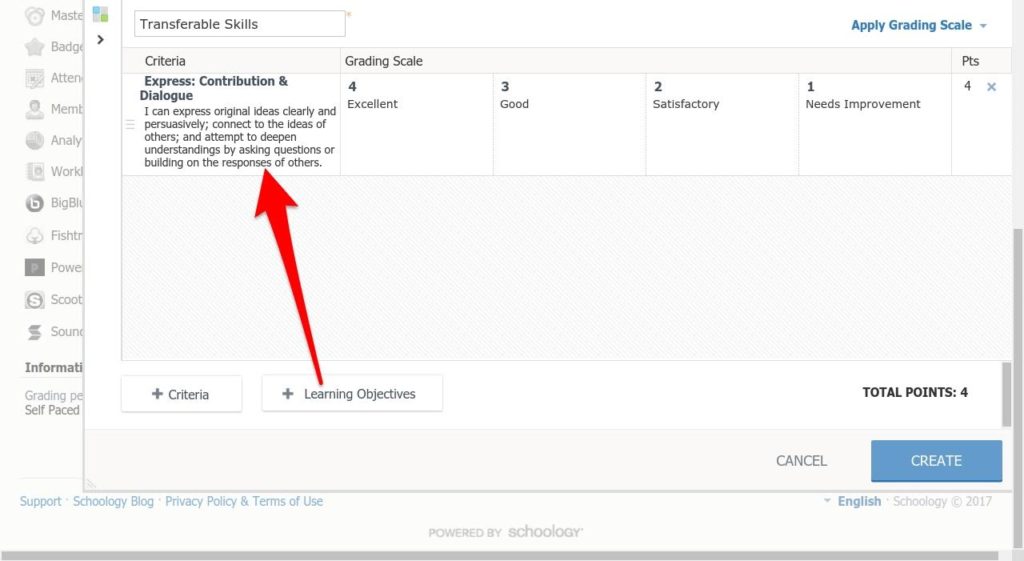3 ways Schoology supports sustainable Proficiency-Based Learning
 A learning management system (LMS) can be used to manage classroom workflow, create self-paced differentiated units, and collaborate within or across classrooms and schools.
A learning management system (LMS) can be used to manage classroom workflow, create self-paced differentiated units, and collaborate within or across classrooms and schools.
As teachers in Vermont and elsewhere grapple with how to create proficiency-based learning environments, they are looking for new strategies and routines. Let’s explore some of the features of the Schoology LMS particularly suited to proficiency-based learning.
The positive potential and practical demands of Proficiency-Based Learning
We’ve talked at length about the benefits of adopting proficiency-based learning, and how student-centered assessment practices create a link between proficiency-based learning and personalization.
But in practical terms, this combination forces teachers to ask: how can I substantially increase the flow of feedback in my classroom, get students more engaged in their own assessment, and provide differentiated learning opportunities, while maintaining sanity and not burning out?
Here are three ways that Schoology can support sustainable practices in a proficiency-based learning environment.
1. Schoology gives learning scales actionable feedback
Why learning scales?
 Learning scales are important tools in a proficiency-based learning environment and can be a good starting point for teachers. They’re visually appealing and are an easy way for students to relate the idea of proficiency to the work they’re actually doing in school.
Learning scales are important tools in a proficiency-based learning environment and can be a good starting point for teachers. They’re visually appealing and are an easy way for students to relate the idea of proficiency to the work they’re actually doing in school.
What do learning scales look like in Schoology?
Each assignment, discussion, assessment question, and scale (rubric) can be aligned to learning targets (objectives).
When students see their efforts on assignments and assessments clearly aligned to learning targets, they can take actionable steps to move toward proficiency.
But how can these learning scales incorporate a rich, meaningful feedback loop?
With Schoology, teachers can build learning scales that link directly to learning objectives. As students work toward the objectives, teachers in Schoology can access students’ assignments and self-assessments and provide actionable feedback via annotation, comment, or audio/video recordings.
What does this look like for teachers?

What does this look like for students?
Students can access their teacher’s feedback and reply to teacher comments. Or, they can simply resubmit the work once they’ve made refinements.

Schoology also records assessment results. And that opens up possibilities for looking at growth over time. Which brings us to:
2. Schoology tracks trends, patterns, and student goal-setting
A proficiency-based system centers on the premise of identifying and addressing gaps in understanding. For this, we require a pedagogical shift: we need to invite students to enter into this process as partners. We need to teach them to self-assess, reflect, and set goals around learning targets.
Schoology offers a way to track students’ increasing proficiency and makes that data visible to the students themselves
Paige Emory, a 6th grade math teacher at Stowe Elementary School, in Stowe VT uses Schoology to track her students’ progress. She intentionally aligns both assignments and assessments to Common Core State Math Standards. Since Schoology allows teachers to customize learning targets, teachers can track progress on transferable skills and habits of work indicators.
Who else could benefit from seeing trends in student learning?
Traditionally, students and families receive information on learning progress via progress reports and report cards. With a mastery tracking system and rapid feedback, students can set goals, revise, rework and resubmit, well before grades come out.
3. Self-directed learning tools
Back to the notion of creating a sane system:
Being responsive to students’ needs in a proficiency-based system requires rapid and timely feedback. And this can strain teachers’ capacity. Schoology supports teachers’ ability to provide learners with multiple and differentiated pathways with two important features.
Automated Quiz-Scoring
The automated quiz-scoring means that teachers can create quizzes and tests that provide immediate feedback. It also allows for multiple retakes. Students have the opportunity to progress at their own speed with multiple opportunities to practice.
Student Completion Rules
The Student Completion Rules allow teachers to provide a group of students with access to the same learning materials, but let them move through the activities at their own pace. Formative checkpoints built into the process help teachers add support for students as the need arises.
Noted edtech blogger Jen Johnson uses Schoology’s Student Completion Rules to control the pacing in her Pop Culture Unit, as well as adding a little gamification.
Seems like an awful lot of work, yes? Why are we doing this again?
Robert Marzano shares research about significant improvement in student achievement when students track their own progress using graphic displays of their data. He believes it’s an effective strategy which receives much less attention than it deserves. And we agree.
Marzano concludes:
When it comes to using classroom assessment to enhance student achievement, having students track their progress using rubrics is a hidden gem. This strategy involves multiple types of assessments, increases interactions between teachers and students, and provides students with clear guidance on how to enhance their learning.



is there a way to create self assessment rubric for students
Yes I think you could pull this off in a number of ways. This blogpost suggests creating a “quiz” with the rubric descriptors as questions, then students can self-assess and you’ll be able to track their responses. If they revise they could self-assess again and resubmit.
https://www.schoology.com/blog/using-schoology-formative-assessment
Great question. Here’s a link to a blog post describing two possible ways for students to self-assess on rubrics in Schoology: https://www.schoology.com/blog/using-schoology-formative-assessment